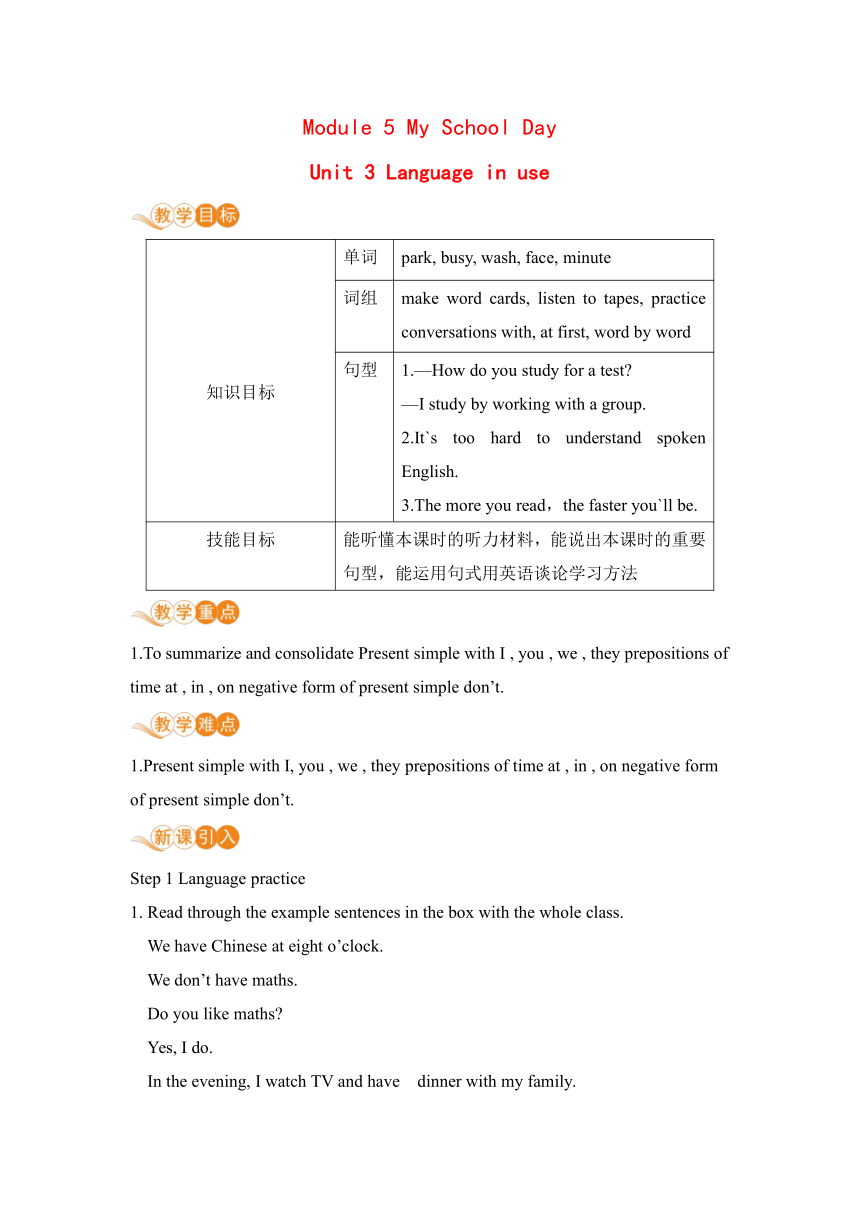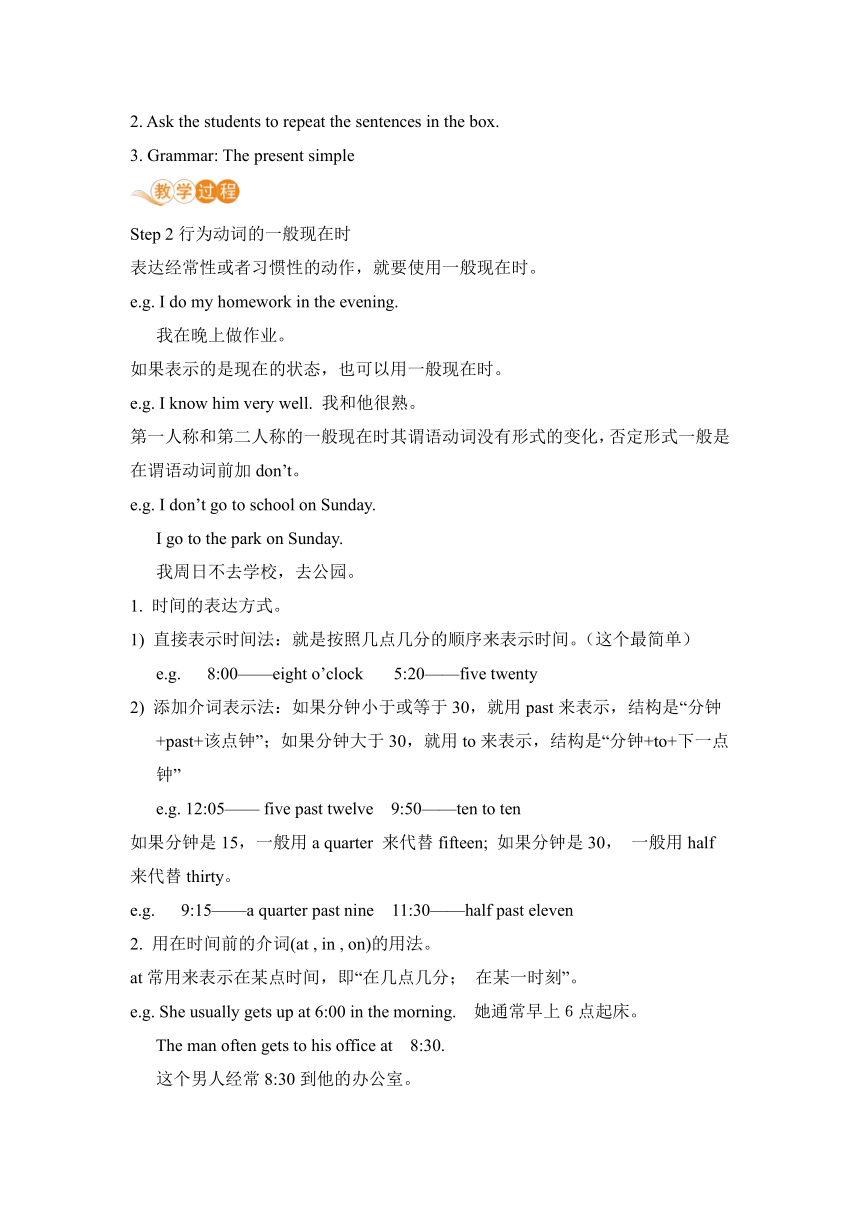Module 5 My School Day Unit 3 Language in use教案
文档属性
| 名称 | Module 5 My School Day Unit 3 Language in use教案 |  | |
| 格式 | docx | ||
| 文件大小 | 210.1KB | ||
| 资源类型 | 教案 | ||
| 版本资源 | 外研版 | ||
| 科目 | 英语 | ||
| 更新时间 | 2023-07-06 17:31:47 | ||
图片预览


文档简介
Module 5 My School Day
Unit 3 Language in use
知识目标 单词 park, busy, wash, face, minute
词组 make word cards, listen to tapes, practice conversations with, at first, word by word
句型 1.—How do you study for a test —I study by working with a group. 2.It`s too hard to understand spoken English. 3.The more you read,the faster you`ll be.
技能目标 能听懂本课时的听力材料,能说出本课时的重要句型,能运用句式用英语谈论学习方法
1.To summarize and consolidate Present simple with I , you , we , they prepositions of time at , in , on negative form of present simple don’t.
1.Present simple with I, you , we , they prepositions of time at , in , on negative form of present simple don’t.
Step 1 Language practice
1. Read through the example sentences in the box with the whole class.
We have Chinese at eight o’clock.
We don’t have maths.
Do you like maths
Yes, I do.
In the evening, I watch TV and have dinner with my family.
2. Ask the students to repeat the sentences in the box.
3. Grammar: The present simple
?
Step 2行为动词的一般现在时
表达经常性或者习惯性的动作,就要使用一般现在时。
e.g. I do my homework in the evening.
我在晚上做作业。
如果表示的是现在的状态,也可以用一般现在时。
e.g. I know him very well. 我和他很熟。
第一人称和第二人称的一般现在时其谓语动词没有形式的变化,否定形式一般是在谓语动词前加don’t。
e.g. I don’t go to school on Sunday.
I go to the park on Sunday.
我周日不去学校,去公园。
1. 时间的表达方式。
1) 直接表示时间法:就是按照几点几分的顺序来表示时间。(这个最简单)
e.g. 8:00——eight o’clock 5:20——five twenty
2) 添加介词表示法:如果分钟小于或等于30,就用past来表示,结构是“分钟+past+该点钟”;如果分钟大于30,就用to来表示,结构是“分钟+to+下一点钟”
e.g. 12:05—— five past twelve 9:50——ten to ten
如果分钟是15,一般用a quarter 来代替fifteen; 如果分钟是30, 一般用half来代替thirty。
e.g. 9:15——a quarter past nine 11:30——half past eleven
2. 用在时间前的介词(at , in , on)的用法。
at常用来表示在某点时间,即“在几点几分; 在某一时刻”。
e.g. She usually gets up at 6:00 in the morning. 她通常早上6点起床。
The man often gets to his office at 8:30.
这个男人经常8:30到他的办公室。
另外,at还可以用在at night(在晚上),at last(最后),at weekends(在周末)at noon(在中午)等固定短语中。
on常用来表示“在某天或星期几”。另外,表示“在某天的上、下午或晚上”时,介词也用on。
in表示“在某一段时间”,如某年、某月、某个季节
e.g. in 1998(在1998年) in March(在三月) in summer(在夏天)
在某一些固定短语中要用in
e.g. in the morning, in the evening,
Step 3 Work in pairs
Ask the students to talk about their activities in a week.
Match the words in Column A with the words and expressions in Column B.
1. Read through the phrases with the whole class.
2. Ask the students to match the words in Column A with the words and expressions in Column B with a partner .
3. Call back the answers from the whole class, check the answers.
Step 4 Complete the passage.
1. Read through the passage with the whole class.
2. Ask the students to complete the passage with the expressions from the box with a partner.
3. Call back the answers from the whole class, check the answers.
Step 5 Complete the sentences with at, in or on.
1. Review the using of at, in and on.
2. Ask the students to fill in the blank individually, and then check with a partner.
3. Call back the answers from the whole class, check the answers.
Step 6 Complete the sentences with the words from the box.
Step 7 Around the world
Step 8 Module task: Talking about your ideal school day.
1. Complete the table with information about your ideal school day.
2. Look through Module 5 and find expressions to say what you do and enjoy every day.
Step 9 Exercises
A.汉译英:
B. 根据短文内容及首字母提示,在空格处填入正确的词,使短文意思
Step 10 Homework
Write a passage about your school day. Is it different from the UK
1.My parents often________ me some gifts on my birthday.
A.buy B.will buy
C.buys D.has bought
2.—________ you do your homework in the evening
—Of course.
A.Does B.Are C.Do D./
答案:1.A 2.C
完成请完成P43对应习题
本课时以小练习的形式与学生互动来导入新课,引出课时的中心。这样既增长了学生关于I, you, we , they作主语的一般现在时的知识,又锻炼了学生的思考能力。
Unit 3 Language in use
知识目标 单词 park, busy, wash, face, minute
词组 make word cards, listen to tapes, practice conversations with, at first, word by word
句型 1.—How do you study for a test —I study by working with a group. 2.It`s too hard to understand spoken English. 3.The more you read,the faster you`ll be.
技能目标 能听懂本课时的听力材料,能说出本课时的重要句型,能运用句式用英语谈论学习方法
1.To summarize and consolidate Present simple with I , you , we , they prepositions of time at , in , on negative form of present simple don’t.
1.Present simple with I, you , we , they prepositions of time at , in , on negative form of present simple don’t.
Step 1 Language practice
1. Read through the example sentences in the box with the whole class.
We have Chinese at eight o’clock.
We don’t have maths.
Do you like maths
Yes, I do.
In the evening, I watch TV and have dinner with my family.
2. Ask the students to repeat the sentences in the box.
3. Grammar: The present simple
?
Step 2行为动词的一般现在时
表达经常性或者习惯性的动作,就要使用一般现在时。
e.g. I do my homework in the evening.
我在晚上做作业。
如果表示的是现在的状态,也可以用一般现在时。
e.g. I know him very well. 我和他很熟。
第一人称和第二人称的一般现在时其谓语动词没有形式的变化,否定形式一般是在谓语动词前加don’t。
e.g. I don’t go to school on Sunday.
I go to the park on Sunday.
我周日不去学校,去公园。
1. 时间的表达方式。
1) 直接表示时间法:就是按照几点几分的顺序来表示时间。(这个最简单)
e.g. 8:00——eight o’clock 5:20——five twenty
2) 添加介词表示法:如果分钟小于或等于30,就用past来表示,结构是“分钟+past+该点钟”;如果分钟大于30,就用to来表示,结构是“分钟+to+下一点钟”
e.g. 12:05—— five past twelve 9:50——ten to ten
如果分钟是15,一般用a quarter 来代替fifteen; 如果分钟是30, 一般用half来代替thirty。
e.g. 9:15——a quarter past nine 11:30——half past eleven
2. 用在时间前的介词(at , in , on)的用法。
at常用来表示在某点时间,即“在几点几分; 在某一时刻”。
e.g. She usually gets up at 6:00 in the morning. 她通常早上6点起床。
The man often gets to his office at 8:30.
这个男人经常8:30到他的办公室。
另外,at还可以用在at night(在晚上),at last(最后),at weekends(在周末)at noon(在中午)等固定短语中。
on常用来表示“在某天或星期几”。另外,表示“在某天的上、下午或晚上”时,介词也用on。
in表示“在某一段时间”,如某年、某月、某个季节
e.g. in 1998(在1998年) in March(在三月) in summer(在夏天)
在某一些固定短语中要用in
e.g. in the morning, in the evening,
Step 3 Work in pairs
Ask the students to talk about their activities in a week.
Match the words in Column A with the words and expressions in Column B.
1. Read through the phrases with the whole class.
2. Ask the students to match the words in Column A with the words and expressions in Column B with a partner .
3. Call back the answers from the whole class, check the answers.
Step 4 Complete the passage.
1. Read through the passage with the whole class.
2. Ask the students to complete the passage with the expressions from the box with a partner.
3. Call back the answers from the whole class, check the answers.
Step 5 Complete the sentences with at, in or on.
1. Review the using of at, in and on.
2. Ask the students to fill in the blank individually, and then check with a partner.
3. Call back the answers from the whole class, check the answers.
Step 6 Complete the sentences with the words from the box.
Step 7 Around the world
Step 8 Module task: Talking about your ideal school day.
1. Complete the table with information about your ideal school day.
2. Look through Module 5 and find expressions to say what you do and enjoy every day.
Step 9 Exercises
A.汉译英:
B. 根据短文内容及首字母提示,在空格处填入正确的词,使短文意思
Step 10 Homework
Write a passage about your school day. Is it different from the UK
1.My parents often________ me some gifts on my birthday.
A.buy B.will buy
C.buys D.has bought
2.—________ you do your homework in the evening
—Of course.
A.Does B.Are C.Do D./
答案:1.A 2.C
完成请完成P43对应习题
本课时以小练习的形式与学生互动来导入新课,引出课时的中心。这样既增长了学生关于I, you, we , they作主语的一般现在时的知识,又锻炼了学生的思考能力。
同课章节目录
- Starte
- Module 1 My teacher and my friends
- Module 2 My English lesson
- Module 3 My English book
- Module 4 My everyday life
- Module 1 My classmates
- Unit 1 Nice to meet you.
- Unit 2 I'm Wang Lingling and I'm thirteen years ol
- Unit 3 Language in use.
- Module 2 My family
- Unit 1 Is this your mum?
- Unit 2 These are my parents.
- Unit 3 Language in use.
- Module 3 My school
- Unit 1 There are thirty students in my class.
- Unit 2 The library is on the left of the playgroun
- Unit 3 Language in use.
- Module 4 Healthy food
- Unit 1 We've got lots of apples.
- Unit 2 Is your food and drink healthy?
- Unit 3 Language in use.
- Module 5 My school day
- Unit 1 I love history.
- Unit 2 We start work at nine o'clock.
- Unit 3 Language in use.
- Revision module A
- Module 6 A trip to the zoo
- Unit 1 Does it eat meat?
- Unit 2 The tiger lives in Asia.
- Unit 3 Language in use.
- Module 7 Computers
- Unit 1 How do I write my homework on the computer?
- Unit 2 When do you use a computer?
- Unit 3 Language in use.
- Module 8 Choosing presents
- Unit 1 I always like birthday parties.
- Unit 2 She often goes to concerts.
- Unit 3 Language in use.
- Module 9 People and places
- Unit 1 We're enjoying the school trip a lot.
- Unit 2 They're waiting for buses or trains.
- Unit 3 Language in use.
- Module 10 Spring Festival
- Unit 1 Are you getting ready for Spring Festival?
- Unit 2 My mother's cleaning our houses and sweepin
- Unit 3 Language in use.
- Revision module B
